Striving for Parity
Striving for Parity
At Bain & Company, our greatest asset is our community of extraordinary teams. We are committed to ensuring Bain is a workplace in which all members of our teams can thrive, personally and professionally.
At Bain & Company, our greatest asset is our community of extraordinary teams. We are committed to ensuring Bain is a workplace in which all members of our teams can thrive, personally and professionally.
Diversity—of gender, background, ethnicity, and sexual orientation and identity—is a strategic imperative for our global firm. Bringing this diversity together, in a way that celebrates and gets the best from it, helps us to offer new perspectives to solve our clients' most challenging problems, to build client relationships that change behaviours and deliver true results, and to deliver unparalleled learning and experience for our employees.
Meritocracy – equality of opportunities and rewards for all our team members – is a fundamental principle of our culture. At each level, base pay is standardised and bonuses are awarded based on performance versus a transparent set of metrics. Overall our London office is 51% women, however our consulting team, and in particular our senior consulting team, skews male. This employee mix causes a gender pay gap when averaged across all roles and levels of the organisation.
We strive to ensure Bain & Company is a great place to work—for everybody. We were ranked #2 best place to work in the UK in the 2019 Glassdoor rankings, and we consistently are recognised in global workplace awards for our commitment to diversity and inclusion. This year we are proud to be named as one of The Times Top 50 Employers for Women in the UK.
Despite our progress to date, we are not satisfied with the gap in gender representation at the senior levels in our firm. We know we have more to do to build a diverse leadership team and achieve gender parity at every level.
Our 2019 Take Action, Gain Traction, based on a survey of nearly 5,000 working professionals, and experience internally and with a number of client organisations, highlights five corporate actions that can improve inclusion and diversity in the workplace.
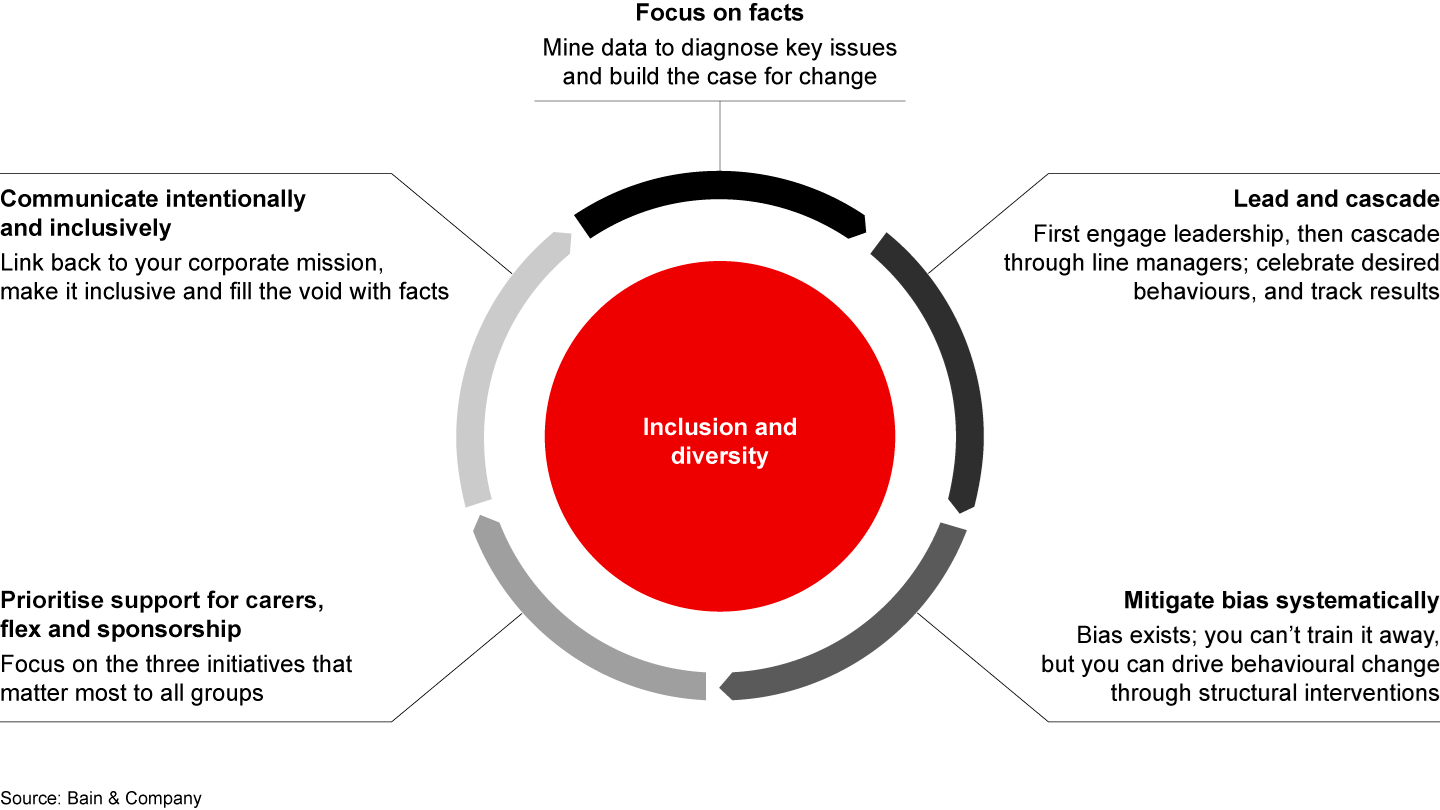
We continue to apply these insights and actions to all forms of diversity to make Bain London the best place to work for everyone, though this particular action plan focuses on gender diversity.
Focus on the facts: Our data shows that, on average, women in our London consulting team are retained and promoted in line with men across all levels. However, we are not complacent and see clear room for improvement when it comes to recruiting, at all levels—more deliberately seeking out qualified women for our open roles and encouraging them to apply. We have seen success in recent years, with our main recruiting intakes delivering 50% women or more. We are continuing to invest to ensure we deliver this consistently across all levels.
Mitigate potential bias systematically: We’ve revamped our graduate recruiting processes, taking extra steps to systematically mitigate potential unconscious bias. We continue to expand what we’ve learned to other areas of recruiting and the business more broadly, including other key talent processes such as promotion, embedding a common language and understanding throughout and drawing on the expertise of our Global Diversity, Equity and Inclusion Centre of Excellence.
Focus on flex, support for carers and sponsorship: We are committed to ensuring all of our employees have the pathways, support and advocates they need to thrive. This includes flexible career paths available to all, including part-time schedules, leaves of absence, and opportunities to transfer to other offices or periodically rotate into different roles.
In 2019 we introduced a new parental leave policy at Bain & Company in the UK. New parents – regardless of gender – will be eligible to receive up to 52 weeks of leave with the first 29 weeks fully paid.
The policy, which covers biological births, adoption and surrogacy, was phased in over the course of 2020 and is now fully in place. The changes aim to remove a barrier to gender equality in the workplace, allowing both parents to spend time with their new child. We saw 100% take-up of this policy during 2020 and similar levels of engagement to date. Creating optionality by offering equal parental leave is one of the most impactful actions that employers can take to move us forward on gender equality and we are proud to be leading the way on this front. We also offer ongoing emergency family care cover for all and a Parents@Bain support network.
In addition to our mentoring programme for everyone at Bain, we offer sponsorship programmes for underrepresented diverse groups, including our senior consulting female population; 90% of our female leaders in London actively engage with a sponsor, who aims to champion them and help them reach their full potential.
While we have long had a culture that encourages various forms of flexible working, we believe that the new equalised and enhanced parental leave is one of the most important steps that we can take to ensure that Bain is a workplace in which all members of our teams can thrive, both personally and professionally.
Lead and cascade: Bain’s Global Women’s Leadership Council brings together leaders across the firm to define strategic gender parity priorities for our firm and its line leaders. Our London DEI Steering Committee, our Women@Bain affinity group and Talent team work closely with me to ensure we deliver on these and increase the visibility of female leaders in our London office. We have similar initiatives in place for other diversity groups as well - such as BGLAD, our LGBTQ network – and we have ally communities to allow others to demonstrate their support.
This year we launched our Inclusion strategy for London to support our ambition to ensure Bain is an environment that celebrates and promotes diversity in all forms, and enables each individual to feel that they belong, have a voice, are valued and are able to thrive and be their true selves every day. As part of this we are actively looking at ways to evolve every day behaviours and signals to ensure a culture of inclusion: we encourage our leaders to understand both personal and professional context for their team members, to transparently role model lifestyle boundaries and trade-offs, and to encourage open, honest dialogues on societal topics that impact our people. To support this we are in the process of rolling out Conscious Inclusion training to everyone in our UK team, beginning with our leadership.
Communicate intentionally and inclusively: We are committed to ensuring Bain & Company remains a community of extraordinary teams, in which all individuals can thrive, personally and professionally. But we are also always dissatisfied with the status quo. We are striving toward gender parity at all levels of our organisation and constantly looking for innovative ways to improve our workplace, challenge ourselves and deliver meaningful results.
— James Hadley | Managing Partner, Bain & Company, Inc. United Kingdom

In aggregate, our London office is comprised of 51% women, however our senior consulting team skews male. This employee mix causes a gender pay gap when averaged across all roles and levels of the organisation, although this is narrowing as our number of senior women increases.
The calculated mean hourly pay for women is 29.3% lower than men (30.2% in 2022), and the median hourly pay is 13.7% lower for women (23.0% in 2022). The median gap has decreased by 9 percentage points from 2022 and has narrowed by a significant 22 percentage points since reporting began in 2017.
The narrowing of the gap in median pay for hourly rates over the last year has been driven by the median pay for females increasing by a greater extent than the median pay for males. This is due to an increase in female representation in the top quartile of our business— the result of focused recruiting efforts over the last few years and continued parity in retention and promotion rates building an increasing pipeline of female leadership and promotions to the most senior levels of our firm. In 2023, we saw female representation in the highest pay quartile increase to 34.9%, up from 31.9% in 2022 and 28.2% in 2021, a result of increased female representation at the Associate Partner and senior Functional Professional level. We have also had more women move into the upper middle quartile of our pay levels, due to an increase in female Senior Managers and Consultants.
At senior levels, performance bonus accounts for a greater portion of total compensation, so the impact of having a smaller proportion of women in our senior team is greater when we look at bonus pay. Our mean bonus pay gap is 76.1% (78.3% in 2022), with a median of 55.2% (59.5% in 2022); both have narrowed since last year, reflecting that we have more women in the leadership team.
The percentages of men and women receiving a bonus are similar, 86.0% for men and 81.5% for women. The small discrepancy for 2023 reflects the timing of bonus payments: Functional Professional employees who joined after 15 April 2022 would not have received a bonus before the snapshot date of this analysis (5 April 2023), and new hires in this population skewed female. Hiring in our general consulting population remains at gender parity.
We continue to take concrete actions to drive progress on gender equality, especially at the senior levels in our firm. This year, we are pleased to have been recognised as one of The Times Top 50 Employers for Women in the UK for the third consecutive year and for the second year running 1st place on Glass Door Places to Work listing.
We are also proud to offer equal parental leave and see male uptake and duration of paid parental leave increasing each year since the policy was launched back in 2019. Our continued dedication to achieving gender equality at all levels is demonstrated through our efforts to embed initiatives that drive increased female representation such as our ‘True North Scholarship for Women’.
We continue to invest in benefits to provide support to all on topics such as fertility, menopause, and childcare. In 2023 we introduced a new fertility policy that enables Bainies to take up to 10 days per year for fertility treatment (inclusive of partners taking time off to support their other half undergoing treatment), and for our Introduced fertility cover for same-sex couples and single women who wish to have a child through our Global PMI scheme.
I confirm that the data is accurate.
— James Hadley | Managing Partner, Bain & Company, Inc. United Kingdom

In aggregate, our London office is comprised of 49% women (45% men, 6% not declared), however, our consulting team, and in particular our senior consulting team, skews male. This employee mix causes a gender pay gap when averaged across all roles and levels of the organisation, although this is narrowing as our number of senior women increases.
The calculated mean hourly pay for women is 30% lower than men (32% in 2021), and the median hourly pay is 23% lower for women (22% in 2021). The median gap has decreased by 6 percentage points from 2020; narrowing by 13 percentage points since reporting began in 2017.
The narrowing of the gap in median pay for hourly rates over the past 5 years has been driven by an increase in female representation in the top two quartiles of our business— the result of focused recruiting efforts over the last few years and continued parity in retention and promotion rates building an increasing pipeline of female leadership and promotions to the most senior levels of our firm. In 2022, we saw female representation in the highest pay quartile increase to 32%, up from 28% in 2021 and 24% in 2020, a result of increased female representation at the Associate Partner level.
At senior levels, performance bonus accounts for a greater portion of total compensation, so the impact of having a smaller proportion of women in our senior team is greater when we look at bonus pay. Our mean bonus pay gap is 78% (81% in 2021), with a median of 60% (65% in 2021); both have narrowed since last year, reflecting that we have more women in the leadership team.
The percentages of men and women receiving a bonus are almost identical. The list of those not receiving a bonus consists only of new Bain hires, who had not yet received their first bonus when we collected the data, therefore the parity we see in this metric reflects the gender parity we have in recruiting.
We continue to take concrete actions to drive progress on gender equality especially at the senior levels in our firm. This year, we are pleased to have been recognised as one of The Times Top 50 Employers for Women in the UK for the second time. We are also proud to offer equal parental leave and see male uptake and duration of paid parental leave increasing each year since the policy was launched in 2019. Our continued dedication to achieving gender equality at all levels is demonstrated through our efforts to embed initiatives that drive increased female representation such as our ‘True North Scholarship for Women’, and our investment in benefits to provide support to all on topics such as fertility and menopause, and childcare.
I confirm that the data is accurate.
— James Hadley | Managing Partner, Bain & Company, Inc. United Kingdom
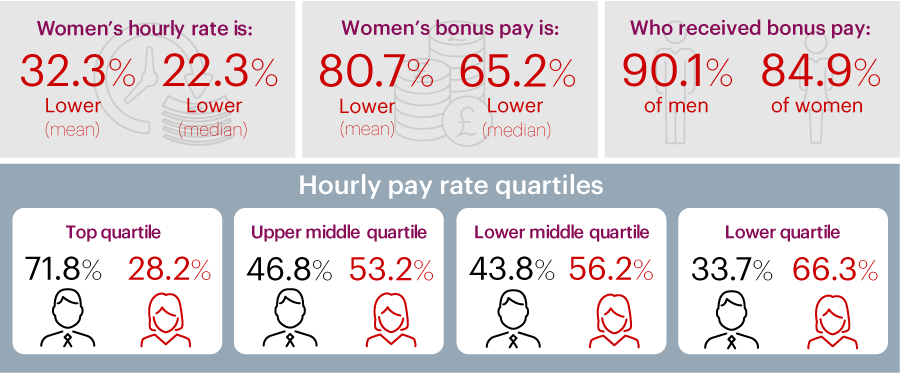
In aggregate, our London office is comprised of 51% women, however, our consulting team, and in particular our senior consulting team, skews male. This employee mix causes a gender pay gap when averaged across all roles and levels of the organisation.
The calculated mean hourly pay for women is 32% less than men, and the median hourly pay is 22% lower for women. The median gap has decreased by 6 percentage points from 2020; narrowing by 14 percentage points since reporting began in 2017.
The narrowing of the gap in median pay for hourly rates has been driven by an increase in female representation in the top two quartiles of our business— the result of focused recruiting efforts over the last few years, with continued parity in retention and promotion rates building an increasing pipeline of female leadership and promotions to the most senior levels of our firm.
At senior levels, performance bonus accounts for a greater portion of total compensation, so the impact of having a smaller proportion of women in our senior team is greater when we look at bonus pay. Our mean bonus pay gap is 81%, with a median of 65% which is 10 percentage points lower than 2017.
The percentages of men and women receiving a bonus reflect new Bain hires, who had not yet received their first bonus when we collected this data.
We continue to take concrete actions to drive progress especially at the senior levels in our firm. This year, we are pleased to have been recognised as one of The Times Top 50 Employers for Women in the UK. We are also proud to offer equal parental leave and we are dedicated to achieving diversity at all levels of our organisation including implementing initiatives to drive increased female talent such as our ‘True North Scholarship for Women’.
I confirm that the data is accurate.
— James Hadley | Managing Partner, Bain & Company, Inc. United Kingdom

In aggregate, our London office is comprised of 49% women, however, our consulting team, and in particular our senior consulting team, skews male. This employee mix causes a gender pay gap when averaged across all roles and levels of the organisation.
The calculated mean hourly pay for women is 30% less than men, and the median hourly pay is 29% lower for women. The median gap has increased by 4 percentage points from 2019 but this gap has narrowed by 7 percentage points since reporting began in 2017.
At senior levels, performance bonus accounts for a greater portion of total compensation, so the impact of having a smaller proportion of women in our senior team is greater when we look at bonus pay. Our mean bonus pay gap is 78%, with a median of 52%. The median gap is 23 percentage points lower than 2017, having declined at a rate of around 6 percentage points per year.
The narrowing of the gap in median pay for both hourly rates and bonus pay has been driven by an increase in female representation in the top two quartiles of our business - the result of focused recruiting efforts over the last few years, with continued parity in retention and promotion rates building an increasing pipeline of female leadership and promotions to the most senior levels of our firm.
The percentages of men and women receiving a bonus reflect new Bain hires, who had not yet received their first bonus when we collected this data.
We understand what is driving these differences and we continue to take concrete actions to drive progress especially at the senior levels in our firm. Our equal parental leave is a lever for change and we are committed to defining and implementing other initiatives that drive increased female representation at all levels of our organisation such as our ‘True North Scholarship for Women’.
I confirm that the data is accurate.
— James Hadley | Managing Partner, Bain & Company, Inc. United Kingdom
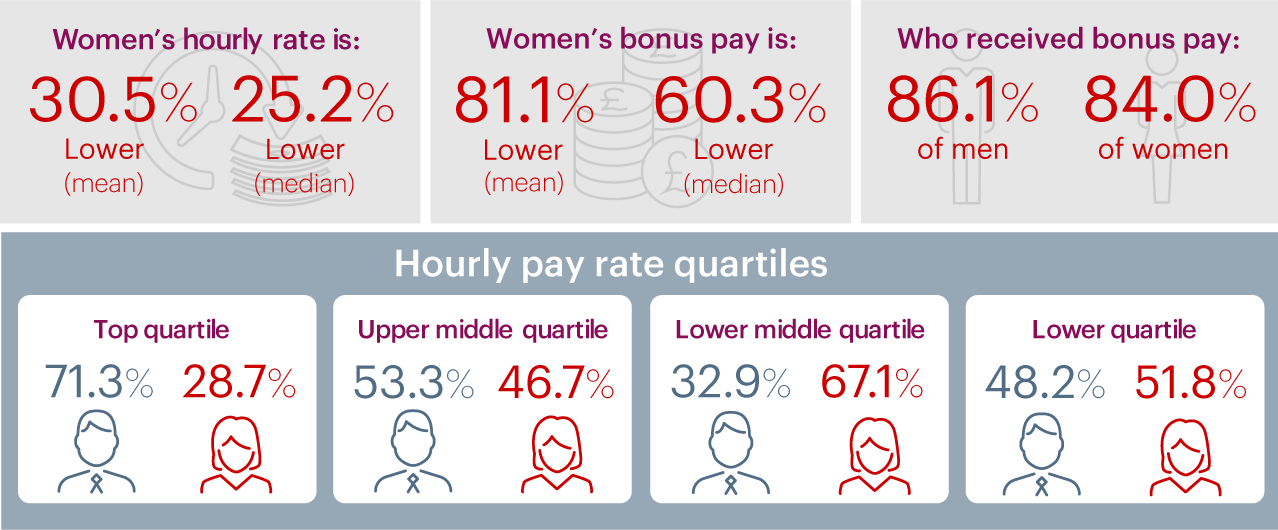
In aggregate, our London office is comprised of 49% women, however, our consulting team, and in particular our senior consulting team, skews male. This employee mix causes a gender pay gap when averaged across all roles and levels of the organisation.
The calculated mean hourly pay for women is 30.5% less than men, and the median hourly pay is 25.2% lower for women. Since reporting began in 2017, the median gap has narrowed by 11 percentage points, at a steady rate of around 5 percentage points per year.
At senior levels, performance bonus accounts for a greater portion of total compensation, so the impact of having a smaller proportion of women in our senior team is greater when we look at bonus pay. Our mean bonus pay gap is 81%, with a median of 60%. The median gap is 15 percentage points lower than 2017, having declined at a steady rate of 7 percentage points per year.
The narrowing of the gap in median pay for both hourly rates and bonus pay has been driven by an increase in female representation in the top two quartiles of our business—the result of focused recruiting efforts in the last few years, an increasing pipeline of female leadership and recent female partner promotions. In 2019, 60% of our partner promotions in London were women.
The percentages of men and women receiving a bonus reflect new Bain hires, who had not yet received their first bonus when we collected this data.
We understand what is driving these differences and we have begun to take concrete actions to drive progress. Equal and enhanced parental leave is a lever for change and we are committed to defining and implementing other policies that drive increased female representation at all levels of our organisation.
I confirm that the data is accurate.
— James Hadley | Managing Partner, Bain & Company, Inc. United Kingdom
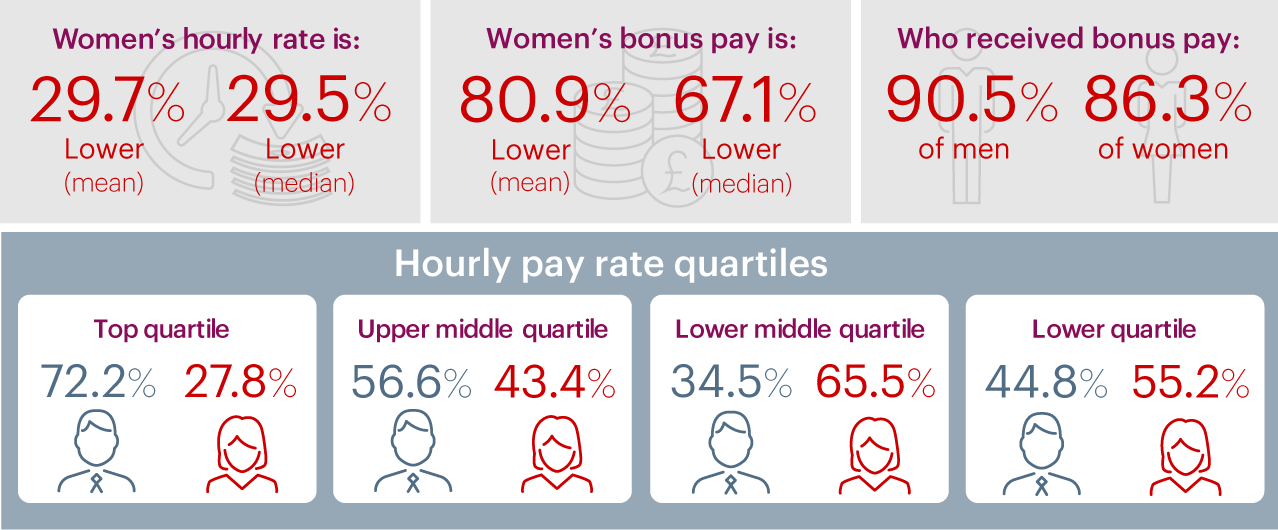
In aggregate, our London office is comprised of 48% women, however, our consulting team, and in particular our senior consulting team, skews male. This employee mix causes a gender pay gap when averaged across all roles and levels of the organisation.
While the mean has not changed since last year, the median gap has narrowed by six percentage points. The calculated mean hourly pay for women is 30% less than men, and the median hourly pay is 30% lower for women.
At senior levels, performance bonus accounts for a greater portion of total compensation, so the impact of having a smaller proportion of women in our senior team is greater when we look at bonus pay. Our mean bonus pay gap is 81%, with a median of 67%. The median gap is 8 percentage points lower than last year.
The narrowing of the gap in median pay for both hourly rates and bonus pay has been driven by an increase in female representation in the top two quartiles of our business, particularly the second quartile—the result of focused recruiting efforts in the last few years.
The percentages of men and women receiving a bonus reflect new Bain hires, who had not yet received their first bonus when we collected this data.
While we understand what is driving these differences, we are not satisfied with the gap in gender representation at the senior levels in our firm, and we are taking action to address it.
I confirm that the data is accurate.
— Michael Garstka | Managing Partner, Bain & Company, Inc. United Kingdom
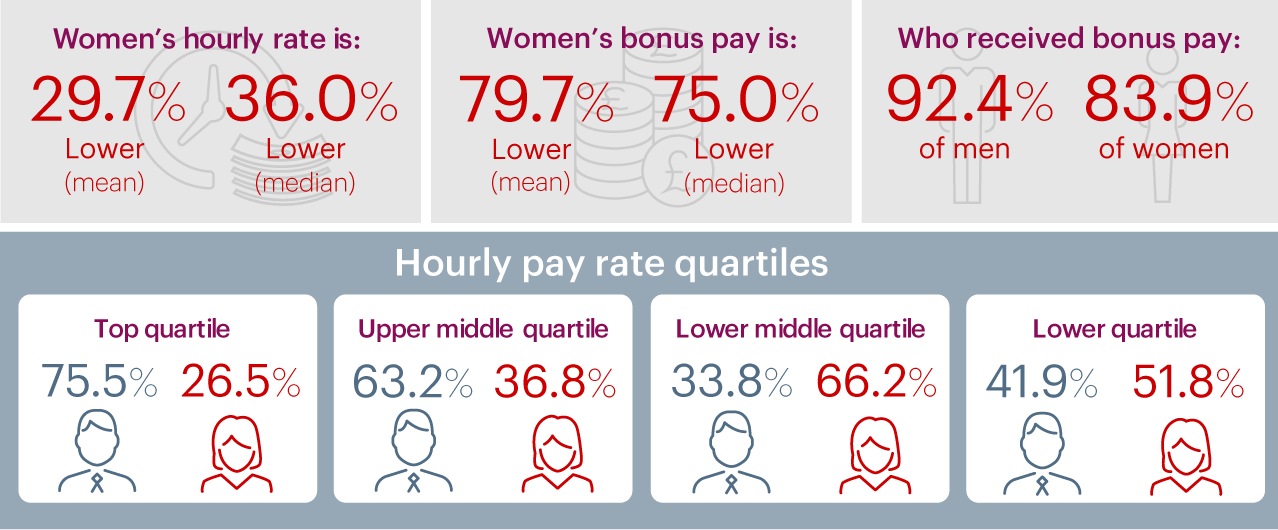
In aggregate our London office is 47% women, however our consulting team, and in particular our senior consulting team, is more skewed towards men. This mix of employees causes us to have a gender pay gap when averaged across all roles and levels of the organisation.
The calculated average hourly pay for women is 30% less than men, and the median salary is 36% lower for women.
At our senior levels, a greater proportion of total compensation is paid as a bonus, compounding this effect in the bonus gender pay gap calculation. Our average pay gap rises to 80%, with a median of 75%.
The percentages of men and women receiving a bonus reflect new Bain hires, who had not yet received their first bonus when we collected this data.
While we understand what is driving these differences, we are not satisfied with the gap in gender representation at the senior levels in our firm, and we are taking action to address it.
I confirm that the data is accurate.
— Michael Garstka | Managing Partner, Bain & Company, Inc. United Kingdom
The Women in Finance Charter is a commitment by HM Treasury (UK government) and signatory firms to work together to build a more balanced and fair financial services industry in the UK. The Charter commits organisations to:
Bain London, as a professional services firm that serves FS clients, has joined more than 400 other signatories to make a step change in accelerating female talent across the industry.
Our Strategy
Our aspiration is to reach parity throughout our organisation: from recruiting, to representation, promotion and retention.
We are on a journey to achieve this, with 50% of our non-leadership recruits being women in 2022, and parity in our promotion and retention. We know we have more to do to reach parity in our leadership levels. We have a clear target and are working on accelerating our support for women along the 10 years it takes to develop a partner whilst continuing to support our junior pipeline to build tomorrow’s leaders.
Target
We reviewed our 2021 commitment and made the decision to increase this from 40% to 45% women in client facing senior management by December 2025. We reviewed progress against these targets in 2023 and are currently on track to meet this commitment.
As of October 2023, we have 44% women in client facing senior management.
Our Gender Diversity Strategy Focuses on Five Actions
Our office leaders drive this change, meeting monthly with our Women Affinity group and DE&I team to launch new diversity initiatives based on these actions, track progress, celebrate role models, and hold leaders accountable across the firm.

